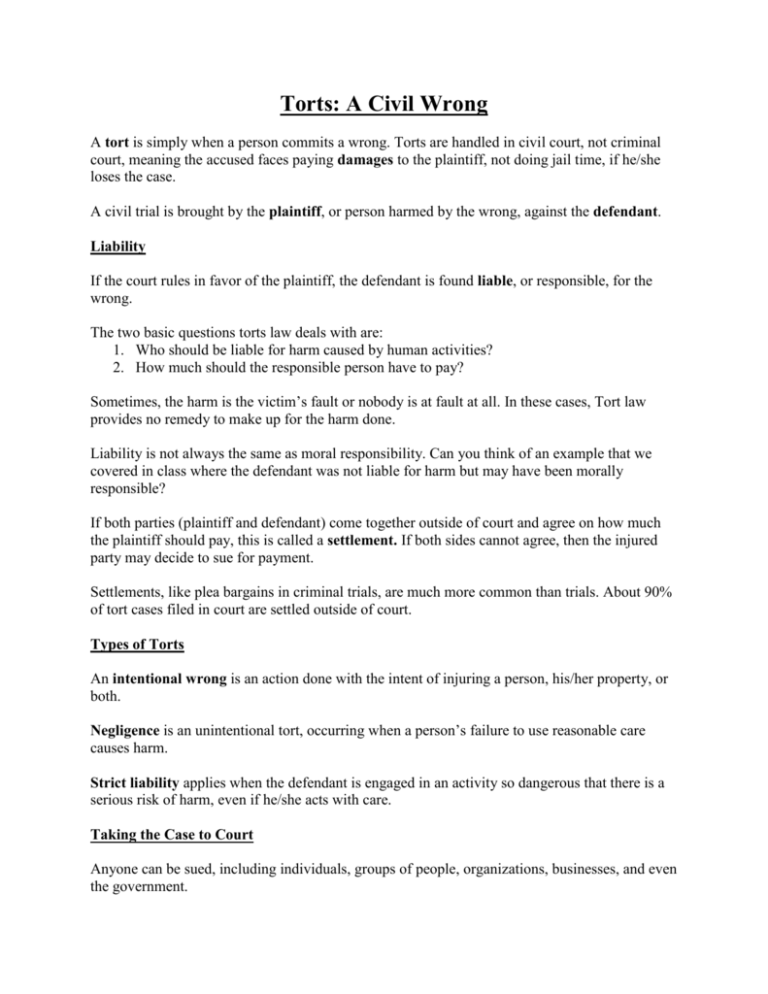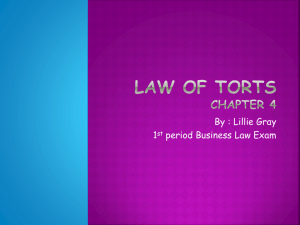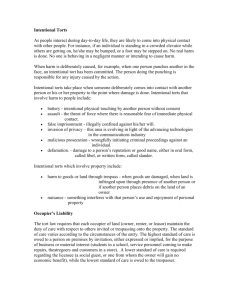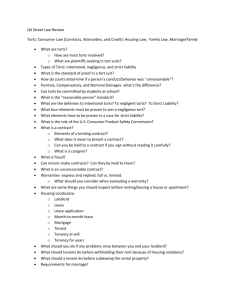Torts: A Civil Wrong - Understanding Liability & Negligence
advertisement

Torts: A Civil Wrong A tort is simply when a person commits a wrong. Torts are handled in civil court, not criminal court, meaning the accused faces paying damages to the plaintiff, not doing jail time, if he/she loses the case. A civil trial is brought by the plaintiff, or person harmed by the wrong, against the defendant. Liability If the court rules in favor of the plaintiff, the defendant is found liable, or responsible, for the wrong. The two basic questions torts law deals with are: 1. Who should be liable for harm caused by human activities? 2. How much should the responsible person have to pay? Sometimes, the harm is the victim’s fault or nobody is at fault at all. In these cases, Tort law provides no remedy to make up for the harm done. Liability is not always the same as moral responsibility. Can you think of an example that we covered in class where the defendant was not liable for harm but may have been morally responsible? If both parties (plaintiff and defendant) come together outside of court and agree on how much the plaintiff should pay, this is called a settlement. If both sides cannot agree, then the injured party may decide to sue for payment. Settlements, like plea bargains in criminal trials, are much more common than trials. About 90% of tort cases filed in court are settled outside of court. Types of Torts An intentional wrong is an action done with the intent of injuring a person, his/her property, or both. Negligence is an unintentional tort, occurring when a person’s failure to use reasonable care causes harm. Strict liability applies when the defendant is engaged in an activity so dangerous that there is a serious risk of harm, even if he/she acts with care. Taking the Case to Court Anyone can be sued, including individuals, groups of people, organizations, businesses, and even the government. Typically, people sue people who can afford to pay damages, such as the owner of a restaurant, as opposed to a janitor or waiter at the restaurant. Employers can be sued for torts committed by employees because they are usually in a better position to pay than the employees. Employers usually purchase liability insurance to cover costs associated with lawsuits. Children who commit torts may also be sued for damages, but because children themselves cannot pay damages, plaintiffs usually sue the child’s parents. Certain defendants are immune from some kinds of torts, suits, meaning that they cannot be suit for certain things. People or groups immune from torts include The federal and state governments, unless the waive, or give up their immunity The president, federal judges, and members of Congress, but only if the alleged tort occurred within the scope of their jobs. Sometimes, there can be more than one plaintiff, from two people to hundreds or even thousands of people. When there is more than one plaintiff, the people harmed form a “class” and bring a class action lawsuit. Some lawyers will work for a contingency fee, meaning the lawyer collects a portion of the money awarded by the court. If the plaintiff loses, the lawyer will receive no compensation. Insurance Insurance is something you pay for hoping never to actually need it. Liability insurance is an agreement in which a person pays set fee, or premium, the size of which depends on how risky the client is, and the insurance company agrees to pay if the client ever causes damages. Some of the more common types of liability insurance are held by doctors, lawyers, and other professionals to protect themselves against malpractice suits. Manufacturers may carry liability insurance in case their products injure people who use them. Homeowners and renters may carry insurance in case property is damaged in a fire or natural disaster or stolen in a burglary. Insurance may also cover injuries to guests in a person’s home. The most important liability insurance for young people is auto insurance.











